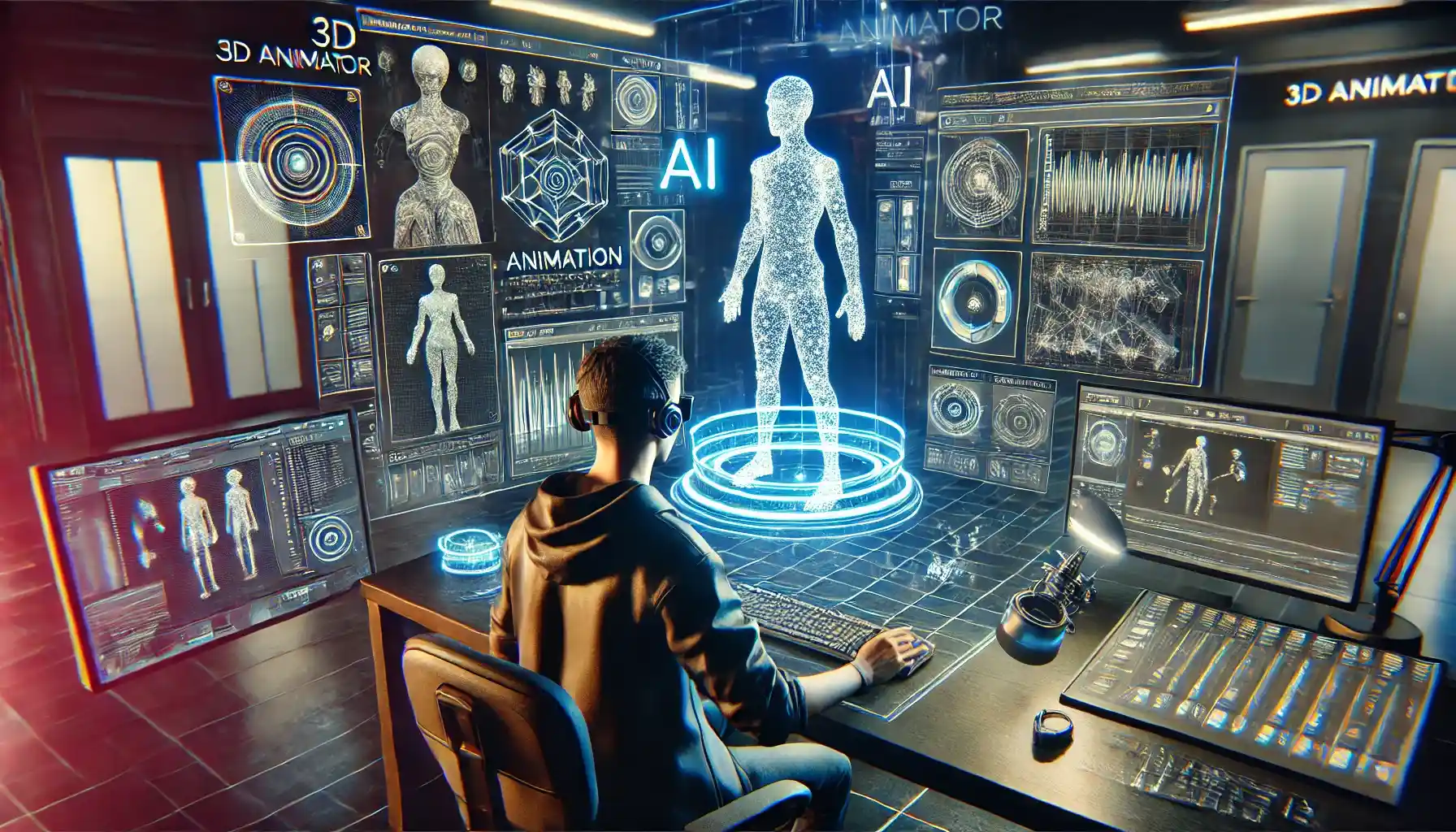The integration of AI into 3D animation is reshaping the industry, creating both opportunities and challenges. Below, we break down the evolving landscape, the skills needed to thrive, and actionable strategies to stay ahead.
1. How AI is Transforming 3D Animation
AI is not a threat but a transformative force that augments workflows and democratizes creativity. Here’s how:
A. Automating Repetitive Tasks
- Examples:
- Rigging: Tools like Auto-Rig Pro use AI to auto-rig characters, reducing hours of manual work.
- Lip-Syncing: Adobe’s Project Reshape syncs facial animations to audio in real-time.
- Rendering: NVIDIA’s DLSS uses AI to upscale low-res renders, saving computational costs.
- Impact: Junior roles (e.g., manual rigging) may shrink, but senior roles (art direction, storytelling) will grow.
B. Democratizing High-Quality Output
- Small Studios: Tools like Blender + AI plugins allow indie teams to create AAA-quality assets.
- Rapid Prototyping: Generate concept art via MidJourney or Stable Diffusion, then refine in 3D software.
C. Unlocking New Creative Frontiers
- Metaverse & VR: AI-generated 3D environments (e.g., Luma AI) enable immersive virtual worlds.
- Personalized Content: AI tailors gaming or film experiences based on user preferences (e.g., dynamic NPCs in games).
2. Skills to Master for the AI-Driven Future
To stay relevant, blend technical proficiency, creative excellence, and adaptability.
A. Technical Skills
- AI-Powered Tools:
- Procedural Generation: Master Houdini for AI-driven environments (e.g., forests, cities) using algorithms.
- Real-Time Engines: Use Unreal Engine 5’s MetaHumans for photorealistic characters or Unity’s Muse for AI-assisted design.
- AI Animation Assistants:
- Cascadeur: Auto-corrects physics in character motion.
- DeepMotion: Converts video clips to 3D animations via AI.
- Coding Basics:
- Python: Automate tasks in Maya/Blender (e.g., batch rendering, asset organization).
- Generative AI Integration: Use APIs to connect Stable Diffusion (for textures) or GPT-4 (for story ideas) to your pipeline.
- Real-Time Collaboration:
- NVIDIA Omniverse: Collaborate globally on 3D projects with AI-enhanced synchronization.
B. Creative Skills
- Storytelling & Emotion:
- AI can’t replicate human empathy. Study Pixar’s “12 Rules of Animation” to master squash/stretch, timing, and appeal.
- Example: The tears in Inside Out’s Sadness were crafted by artists, not algorithms.
- Art Fundamentals:
- Anatomy: Even stylized characters (e.g., Spider-Verse) need believable proportions.
- Lighting & Composition: Use Blender’s Cycles to study how light interacts with materials.
- Style Innovation:
- AI mimics trends, but humans invent. Develop a signature style (e.g., Genndy Tartakovsky’s bold lines in Samurai Jack).
C. Adjacent Fields
- Metaverse/VR Development:
- Design 3D assets for Meta Horizon Worlds or Decentraland using Blender or Maya.
- Learn spatial storytelling for interactive VR experiences.
- Game Development:
- Integrate animations into Unreal Engine with Control Rig for responsive gameplay.
- Study player psychology to design engaging mechanics.
- VFX & Simulations:
- Master Houdini for destruction effects (e.g., Game of Thrones’ collapsing buildings).
- Use RealFlow for fluid dynamics in commercials or films.
D. Soft Skills
- Collaboration: Work with writers, programmers, and sound designers to build cohesive projects.
- Adaptability: Stay updated on tools like Sora (AI video) or Wonder Dynamics (AI character integration).
- Problem-Solving: Turn vague client requests into actionable plans (e.g., “Make it epic” → Define mood boards, pacing, and color palettes).
3. Strategies to Thrive in the AI Era
A. Adopt a Hybrid Workflow
- AI as a Co-Pilot:
- Use RunwayML to generate storyboard drafts, then refine them manually.
- Example: AI creates a basic cityscape; you add unique landmarks and cultural details.
B. Build a Future-Proof Portfolio
- Showcase Diversity:
- Include AI-assisted projects (e.g., “Procedural terrain made in Houdini + AI”).
- Highlight traditional skills (hand-drawn sketches, clay modeling).
- Platforms: Use ArtStation for 3D art, GitHub for coding projects.
C. Continuous Learning
- Follow Trends:
- Neural Rendering: Tools like NeRF (NVIDIA’s Instant NeRF) turn 2D photos into 3D scenes.
- AI Avatars: Platforms like Inworld AI create lifelike NPCs for games.
- Communities: Join Blender Artists Discord, AI Art subreddits, or CGSociety.
D. Business Acumen
- Freelancing:
- Offer AI-driven efficiency (e.g., “Reduce project time by 40% using procedural textures”).
- IP & Ethics:
- Understand copyright laws for AI-generated assets (e.g., Who owns art made via MidJourney?).
4. The Human Edge: Why AI Can’t Replace You
- Intent & Culture: AI lacks context. Only humans can infuse stories with cultural nuances (e.g., Coco’s Day of the Dead symbolism).
- Empathy: Characters like Wall-E or Frozen’s Elsa resonate because artists embedded emotions AI can’t replicate.
- Innovation: AI recycles data; humans invent. Think of Cel-Shading (Zelda: Breath of the Wild) or Stop-Motion Hybrids (Kubo and the Two Strings).
Conclusion: Embrace the AI Renaissance
The future of 3D animation isn’t about humans vs. AI—it’s about humans + AI. By mastering tools like Houdini, Unreal Engine, and Python, while doubling down on storytelling and originality, you’ll not only survive but lead the next wave of creativity.
Action Steps:
- Learn One AI Tool
- Join a Community
- Experiment: Merge AI-generated concepts with your unique style.
The artists who thrive will be those who see AI not as a threat, but as the ultimate collaborator. 🚀
NovaFx
3d animation and Master for the AI-Driven Future

